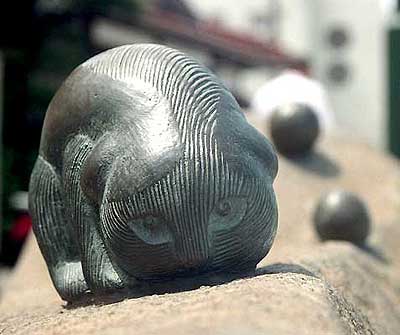Calendars and Full Moons
MM,
As the year draws to a close, I found myself immersed in the subject of calendars. A boring subject for most people, however calendars are quite important to any pagan or anyone who wants to live according to nature’s cycles.
This little bit of study spawned off of me planning my next year of moon rituals. For awhile now, I’ve been wanting to do a full year of personal moon rituals (for me or for me and my partner). The idea behind this is to attune to the cycle of the moon and the seasons. For this, I decided to work through a set of moon rituals presented in Enchanted by Titania Hardie. The author of this book is using what is commonly known as “Celtic Tree Months” – birch, rowan, ash, alder, willow, hawthorn, oak, holly, hazel, vine, ivy, reed, and elder. This calendar is adapted from Robert Graves’ in his book The White Goddess which lists these 13 months. Of course, there are some major differences between Hardie’s suggested calendar and Graves – one of which is that she is trying to ensure 13 full moons in a year (which does not occur ever year). In contrast, Graves has fixed his calendar to the winter solstice (which is the last day of the 13th month and is normally on the 21st of December) and created 13 months each consisting of 28 days (which he calls a lunar year). Since 13 months of 28 days is only 364 days in a year, Graves has indicated that the day after winter solstice is the intercalary day (also the last day of the year). This is where the common pagan term “a year and a day” comes from. It refers to Graves’ 13 lunar months and the extra (intercalary) day. Note of course that Graves’ calendar does not suggest there are always 13 full moons in a year or 13 new moons in a year. Actually, you will be missing at least a full moon or a new moon except in the years where there is a 13th new moon or full moon (more on this later below). This means that to celebrate 13 lunar months, a practicing pagan will have to adapt and do some new moon rituals as well if she wants to celebrate all 13 moons.
Of course, me being a inquisitive pagan and loving math, I decided to look into what is called a lunisolar calendar wondering if this would be more practical. Some of the more famous lunisolar calendars are the Chinese calendar and the Hebrew (Jewish) calendar. Lunisolar means that the calendar is reconciling the lunar year with the solar year. This occurs every 19 years and the 19 year cycle is called the Metonic cycle. Why does this occur? First, a true lunar month (synodic month) is about 29.53 days and a solar year is about 365.25 days. A lunar year of 12 months is 354.36 days, just about 11 days short of a solar year. (Note: 13 lunar months is 383.89 days, 18 days more than a solar year.) In 19 solar years, it works out that there will be 235 synodic months. Here’s some of the calculations:
365.25 days x 19 years = 6939.75 days
6939.75 days / 29.53 days = 235 synodic months
29.53 days x 235 synodic months = 6939.55 days
Note the days in bold. Based on the lunar month, after 19 years, we’re just short by 0.2 days, a few hours. On a practical note, this means that your REAL birthday comes around again in 19 years give or take a few hours and by REAL birthday I’m referring to the position of the stars on your birthday. In 19 years, the stars should be basically the same as when you were born.
Because the lunar year is shorter than the solar year by about 11 days, every so often an intercalary month is required. Recall that in 19 years, there should be 235 months. If our calendar consisted of only 12 lunar months every year for 19 years, we’d only have 228 months, 7 months short. This means that the 7 intercalary months need to be inserted throughout the 19 year cycle to ensure that the months occur around relatively the same time each year.
In comparison to Graves’ calendar, the lunisolar calendars seem more practical adding the extra lunar month every few years as you don’t feel like you lost a moon to celebrate! The most important difference is the 13 months in Graves’ versus the 12 months in the lunisolar calendars.
The other important topic regarding Graves’ calendar and the “Celtic Tree Calendar” is whether there is some basis for considering these to be Celtic. Graves’ in his book never calls his calendar Celtic and frankly it is obvious that he was creating a calendar to his liking. What he did was associate a poem, The Song of Amergin, to the 13 months and then associate 13 of the ogham to the months. It is from the ogham where we get the names of Graves’ months. If Graves’ calendar is not truly Celtic in origin, then what is? The Coligny calendar is thought to be a true Celtic calendar. It was found 1897 in the Celtic region, Gaul. The calendar has 12 months and tracks the lunar monthly cycle. It is disputed among scholars and contemporary pagans about where the month starts. Some claim it starts on the full moon while others suggest the new moon. Yet, some evidence points to the month starting on the 6th or 7th day after the new moon, i.e., the first quarter. (In comparison, the months begin on the new moon in the Chinese calendar.) The names of the months are known though and it is known that the calendar inserted the intercalary month every few years, suggesting that the Coligny calendar was also a lunisolar calendar. The names of the Coligny calendar months are below (along with the Gregorian equivalents):
Samonios (October to November)
Dvmannios (November to December)
Rivros (December to January)
Anagantios (January to February)
Ogronios (February to March)
Cvtios (March to April)
Giamonios (April to May)
Simivisonnos (May to June)
Eqvos (June to July)
Elembivios (July to August)
Edrinios (August to September)
Cantlos (September to October)
The Coligny calendar divided the year into two halves – Samonios began the dark half and Giamonios began the light half. We also know that the Celts counted the start of the day at sunset. The days went from sunset to sunrise (which is an amusing perspective for any pagan).
Another Celtic-based calendar is one found in The Apple Branch by Alexei Kondratiev, a well-known Celtic scholar. Like Graves’, this calendar has 13 months but each month varies between 27 to 29 days, so that there is no intercalary day. The calendar starts in October 30, on Samhain what is commonly known as the Celtic New Year. Because of the 13 months, this calendar operates much like Graves’ – you’ll get the 13 full moons or 13 new moons every few years.
Another calendar I looked at is a Lakota calendar from Earth Signs by Grey Wolf. This calendar is fairly straight forward and simple. There are 12 months and the year starts in March around the spring equinox. The moon cycle is then just tracked during the 12 months. According to the author, each month starts on the 11th of each Gregorian month (though I think he’s just making it simple for non-Lakota people).
With all these different calendars available to use, I decided to do a practical comparison. I set up a spreadsheet file (in Excel format) containing some of the calendars and a calendar I “created” using the Celtic tree months. My idea for the 13 months was to have Elder and Birch share their month except for when there is the 13th moon every few years. The calendar is somewhat fixed in that the winter solstice is always in the last month of Elder. Each month started on the new moon. I felt this worked better than another idea presented by faeriefaith.net which was to split up the month so that Elder and Birch each had their own month. However, that idea meant that often either Elder or Birch had a short month and that one will get the new moon while the other will get the full moon. That calendar fixed the winter solstice to Elder and Imbolc to Rowan. In comparison, I rather like Graves’ and Kondratiev’s calendar and I don’t see why this person rejected Graves’.
After filling my head up with all this stuff about calendars, I still am to celebrate 13 moons. I figure I can use my calendar or Graves’ – either way, the current moon is birch (new moon – December 30, 2005; full moon – January 14). One major reason to use Graves’ calendar instead of mine is that the 8 sabbats fall in the same tree month each year whereas it may vary with mine depending on where the moon is. I guess it really depends on whether one wants consistency or changeability when planning full moon rituals.
In relation to celebrating the full moons, I looked up full moon names and found some consistency though a variety of names for some full moons. I thought perhaps these moon names will provide some ideas of how to celebrate each full moon. I have yet to settle on moon names for each month that I find suitable to the cycle where I live. Some full moon names for each month can be found on the Excel file I’ve provided above. In addition, there is a chart for planetary hours for those people who like to plan down to the exact hour.
We are now in the birch “moonth” which represents beginnings and it seems to be fitting since this is the time of year where we begin new things even if it’s just thinking of them – conception of an idea is definitely something belonging to birch.
BB,
Cassandrah
Your local webmistress
Brigid’s Flame
Sources:
http://en.wikipedia.org/wiki/Lunisolar
http://en.wikipedia.org/wiki/Chinese_calendar
http://www.infoplease.com/ipa/A0002076.html
About the Celtic tree calendar:
http://www.faeriefaith.net/treecal.html
http://www.the-tree.org.uk/Sacred%20Grove/treecalendar.htm
About the Coligny calendar:
http://www.livingmyths.com/Celticyear.htm
http://www.roman-britain.org/cycle.htm
http://www.roman-britain.org/coligny.htm
Sites with Full Moon Names:
http://en.wikipedia.org/wiki/Full_moon
http://www.angelfire.com/de2/newconcepts/wicca/moons2.html
http://www.farmersalmanac.com/astronomy/fullmoonnames.html
http://www.space.com/spacewatch/full_moon_names_2005.html
http://home.hiwaay.net/~krcool/Astro/moon/moonnames.htm



